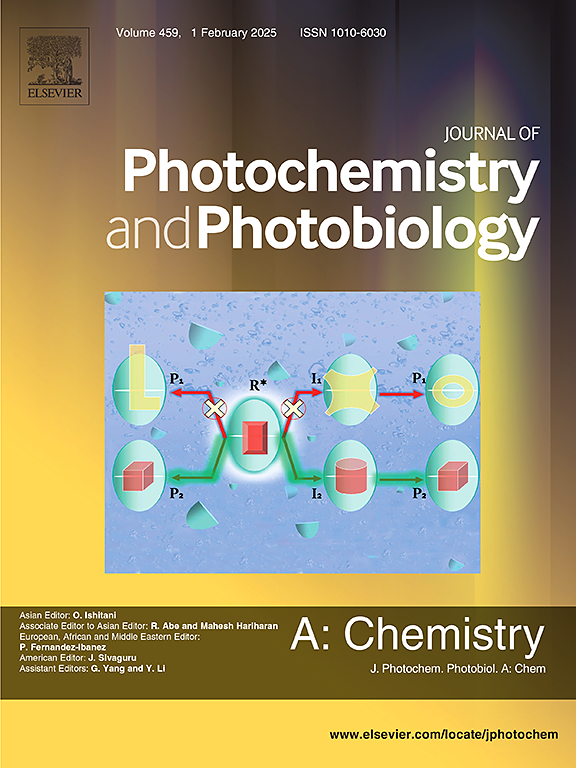Box-Behnken experimental design to optimize the degradation of methyl orange by β-cyclodextrin-assisted photo-Fenton
IF 4.1
3区 化学
Q2 CHEMISTRY, PHYSICAL
Journal of Photochemistry and Photobiology A-chemistry
Pub Date : 2025-04-01
DOI:10.1016/j.jphotochem.2025.116419
引用次数: 0
Abstract
Cyclodextrins (CDs) are cyclic oligosaccharides that form inclusion complexes with organic pollutants due to their hydrophobic cavities. This study focused on optimizing the conditions for the degradation process of Methyl Orange (MO) in a homogeneous aqueous medium through β-cyclodextrin (β-CD) assisted photo-Fenton. A Box-Behnken experimental design was implemented, and the response surface methodology (RSM) was applied to predict and optimize the optimal conditions for MO removal. The experimental data fit a statistically valid quadratic model according to an analysis of variance (ANOVA), yielding a determination coefficient of R2 = 0.9966, indicating a 95 % predictive accuracy. Optimization via RSM revealed that the ideal conditions to achieve a maximum removal of 96.4 % were: [β-CD] = 21 μM, [Fe2+] = 121 μM, [H2O2] = 7571 μM, and a pH of 4.2. Experimental verification of these conditions resulted in a degradation efficiency of 95.3 %, with a relative error of 1.15 %, demonstrating its proximity to the predicted value, highlighting the potential for scaling this approach to more complex systems. Thus, the methodology used proves to be an efficient and economically viable solution for the treatment of wastewater contaminated with dyes.

优化β-环糊精辅助光fenton降解甲基橙的Box-Behnken实验设计
环糊精(CD)是一种环状低聚糖,由于具有疏水空腔,可与有机污染物形成包合物。本研究的重点是优化在均相水介质中通过β-环糊精(β-CD)辅助光-芬顿降解甲基橙(MO)的条件。实验采用箱-贝肯实验设计,并应用响应面方法(RSM)预测和优化了去除 MO 的最佳条件。根据方差分析(ANOVA),实验数据符合统计学上有效的二次方模型,确定系数为 R2 = 0.9966,表明预测准确率为 95%。通过 RSM 进行优化后发现,达到最大 96.4% 去除率的理想条件是[β-CD] = 21 μM,[Fe2+] = 121 μM,[H2O2] = 7571 μM,pH 值为 4.2。对这些条件进行实验验证后,降解效率为 95.3%,相对误差为 1.15%,表明其接近预测值,突出了将这种方法推广到更复杂系统的潜力。因此,所使用的方法被证明是处理受染料污染的废水的一种高效且经济可行的解决方案。
本文章由计算机程序翻译,如有差异,请以英文原文为准。
求助全文
约1分钟内获得全文
求助全文
来源期刊
CiteScore
7.90
自引率
7.00%
发文量
580
审稿时长
48 days
期刊介绍:
JPPA publishes the results of fundamental studies on all aspects of chemical phenomena induced by interactions between light and molecules/matter of all kinds.
All systems capable of being described at the molecular or integrated multimolecular level are appropriate for the journal. This includes all molecular chemical species as well as biomolecular, supramolecular, polymer and other macromolecular systems, as well as solid state photochemistry. In addition, the journal publishes studies of semiconductor and other photoactive organic and inorganic materials, photocatalysis (organic, inorganic, supramolecular and superconductor).
The scope includes condensed and gas phase photochemistry, as well as synchrotron radiation chemistry. A broad range of processes and techniques in photochemistry are covered such as light induced energy, electron and proton transfer; nonlinear photochemical behavior; mechanistic investigation of photochemical reactions and identification of the products of photochemical reactions; quantum yield determinations and measurements of rate constants for primary and secondary photochemical processes; steady-state and time-resolved emission, ultrafast spectroscopic methods, single molecule spectroscopy, time resolved X-ray diffraction, luminescence microscopy, and scattering spectroscopy applied to photochemistry. Papers in emerging and applied areas such as luminescent sensors, electroluminescence, solar energy conversion, atmospheric photochemistry, environmental remediation, and related photocatalytic chemistry are also welcome.

 求助内容:
求助内容: 应助结果提醒方式:
应助结果提醒方式:


